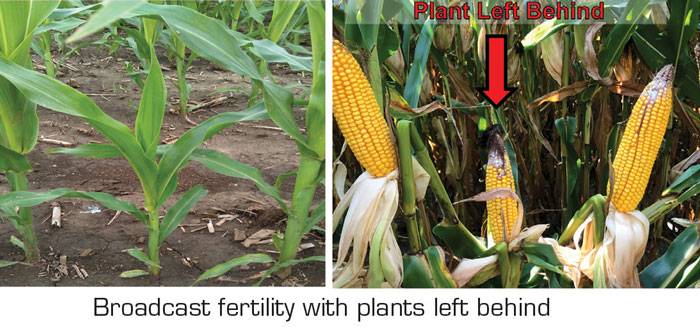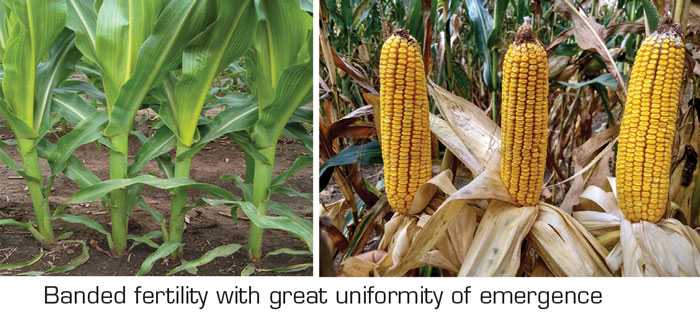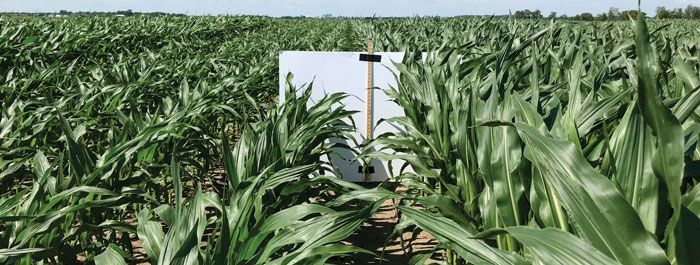Do you know the current corn yield world record?
You probably heard Charles City, Va., grower David Hula set it in 2019 with 616 bushels.
But do you know the current corn yield gap?
The corn yield gap, says Scott Foxhoven, is the 439-bushel difference between the world record and the average U.S. corn yield of 177 bushels.
“Four hundred and thirty-nine bushels of growing room between what’s possible and what’s typical,” says Foxhoven, who is a third-year PhD student with the lab of University of Illinois crop scientist Fred Below, best known for his “Seven Wonders of the Corn Yield World.”
If you asked Hula or another corn yield record grower what their strategy is, Foxhoven says they’ll tell you to feed and protect a higher density of the best racehorse hybrids. That starts with providing adequate fertility right from the start. One of the keys to achieving better nutrition is through fertilizer placement.
Foxhoven explains research conducted by the University of Illinois on banding vs. broadcasting fertilizer, when it’s most advantageous to band and what strip-tillers can do to ensure they’re providing their corn enough fertility in the right place.
Root Sizes Influence Banding Advantage
How much of a difference does fertilizer placement have on corn yield? As the University of Illinois discovered, it depends.
In a 2019 corn hybrid study, university researchers took 10 hybrids with maturities ranging from 110-114 days, planted them at three populations — 30,000, 36,000 and 42,000 — and then tested them under two different fertility plans.
Both plans included the same amount of fertilizer: 280 pounds of pre-planted nitrogen (N), 75 pounds of monoammonium phosphate (MAP) and 60 pounds of potassium chloride (MOP). The difference was in their application. One plan broadcasted and lightly incorporated with a harrow the MAP and MOP, while the other plan subsurface-banded them. Corn that only received N served as the control group.
No Corn Plant Left Behind


NO CORN PLANTS LEFT BEHIND. To confirm whether your corn is getting adequate fertility from broadcast applications, go out in your field and look for any corn plants that were “left behind,” Foxhoven says. The stunted plants on the left are in a field that was broadcast fertilized, while the right plants were in a field that had fertilizer banded. “Once that plant falls behind, it’s basically a weed,” says Foxhoven.
Averaged across the 10 hybrids and three populations, broadcast-fertilized corn yielded 220 bushels per acre, while the banded-fertilized corn yielded 228.
“That banded application gave me an additional 8 bushels per acre,” Foxhoven says. “That’s just changing the placement of that fertility.”
But the results weren’t as consistent when they looked at the corn by the different populations.
At 30,000 plants per acre, the yield was the same for both broadcasted and banded fertilizer at 223 bushels per acre. But as the populations increased, that changed. At a population of 36,000, corn yielded 225 bushels per acre with banded fertilizer, 9 bushels more than the 216-bushel yield for broadcasting. And at 42,000, corn yielded 226 bushels per acre from banded fertilizer, a 12-bushel difference from the 214-bushel yield for broadcasting.
Foxhoven points out two interesting observations. One is that banding proved to be more advantageous over broadcasting as populations increased. But they also saw yields drop with broadcast fertilizing as populations grew — the two higher populations yielded 7 and 9 bushels less, respectively, compared to the 30,000 population.
“Why in the world would I have less of a response of fertility at higher populations with broadcast?” Foxhoven asks.
The answer: root size.
As corn populations increase, the plant’s root system shrinks, he explains. University of Illinois research confirms this. By collecting roots at VT/R1, researchers found that as the population increased by 6,000 plants per acre, the root balls decreased in size by 10-12%.
“If I put down a broadcast application, I’m expecting that big old root ball to be able to access a lot of that,” Foxhoven says. “But when I start going up into these higher populations, I can see why that broadcast fertility isn’t going to be as available for that crop. That tells you that if you’re going to be planting at these higher populations — and higher populations are on the rise — you’re going to see smaller roots need to have better placement of fertility.”
How Hybrids Play a Role
One influence on the size of a corn root is the corn hybrid. In that same study, Foxhoven says there was a range in response of fertility across those 10 hybrids. Some were “fertility hogs” and wanted a lot of fertilizer, while others had impressive responses from broadcasting.
“That tells me that hybrid selection is very crucial when I’m looking at the response to these different management factors,” he says. “It’s the difference between a racehorse hybrid and a workhorse hybrid.”
But what makes a hybrid a workhorse or a racehorse? It’s how they respond under intensive management strategies.
Response to Banded Fertility

DIFFERENCE IN FERTILIZER PLACEMENT. The corn plants shown here are the same hybrid, same population and were planted on the same date. The only difference is the fertilizer was banded for the corn on the right, while it was broadcasted for the corn on the left.
To illustrate, Foxhoven picked six hybrids from a commercial hybrid university study, where they evaluated 47 hybrids across three research locations in the state and subjected them all to different levels of management.
The standard level of management included a broadcast application of 100 pounds of MAP and 75 pounds of MOP, along with 180 pounds of pre-planted N, regardless of soil test results. This level was planted at a population of 36,000 in 30-inch rows.
From there they examined how the hybrids responded to these additional management factors:
- Sidedressing 60 pounds of N
- Banding MicroEssentials-SZ and broadcasting Aspire
- Applying fungicide at VT/R1
- Increasing the population to 44,000
Of the six hybrids Foxhoven selected, three produced standard Illinois yields — 236-249 bushels per acre — under the standard level of management. But when they added all of the extra layers of management to them, it barely made a difference. One hybrid saw a 10-bushel increase, another 8, while the third actually yielded 2 bushels less under more intensive management.
For the other three hybrids, the story was almost the exact opposite. Their yields under the standard level of management ranged from 219-239 bushels per acre, but they all saw huge yield increases with the additional management — between 62 and 84 bushels more, resulting in yields of 283-309 bushels per acre.
These six hybrids show that workhorse hybrids — the first group of three — can yield well with a basic level of management, while growers can push racehorse hybrids even further.
Once again, the main difference between the two comes down to root size. Foxhoven says racehorse hybrids have smaller root systems so there’s less root crowding and higher yield potential. However, because they don’t have the root system to mine for nutrients, they’re also more susceptible to stress. That’s why adding those extra management factors, along with banding fertilizer, helps small-rooted hybrids to be more responsive to high population and fertility.
“If you’re going to start chasing some of those high management factors, you have to start looking at what kinds of hybrids you’re placing,” Foxhoven says.
Address All Stress Factors
Because small-rooted hybrids are more susceptible to stress, growers shouldn’t expect to see a yield response to banding if they’re not taking care of the basics.
A 2020 hybrid study in Nashville, Ill., where southern rust is a big issue, serves as a good example of this.
“We got to watch the crop just melt away with southern rust,” Foxhoven says. “You went in there with a white t-shirt, you came out looking like an Oompa Loompa.”
Once again, they had a standard level of management — 36,000 plant population and 160 pounds of N — as well as six levels of additional management:
- 60 pounds of N sidedressed at V6
- 80 pounds each of phosphorus (P) and potassium (K) broadcasted
- 80 pounds each of P and K banded
- Fungicide application at VT/R1
- High population of 44,000 plants per acre
- Planted in 20-inch rows
The average yield for standard management was 173 bushels per acre. Adding a sidedress application only bumped it up 1 bushel. Broadcasting fertilizer actually reduced yield by a bushel, despite the soil tests indicating it needed P and K, while banding only increased it by 1.
But when they added a fungicide application, they saw an average 25-bushel increase. “I was not going to have a response to anything until I put down that fungicide application,” Foxhoven says. “That’s Liebig’s Law of Minimums. You have to address every component.”
Another trial in southern Illinois supports this. There he did a rescue fungicide application at R3. Corn yields where P and K were broadcasted averaged 191, while the banding application provided a 10-bushel bump.
Foxhoven points out that the 25-bushel increase he saw from fungicide application in the hybrid trial wouldn’t have happened if he didn’t have the fertility there too. When adding up the yield advantage of all six management layers, it resulted in a 63-bushel advantage.
“That is not possible on that soil unless you’re addressing that fertility,” Foxhoven says. “But you also had to address the other components like disease.”
Banding ‘N’ Proves Beneficial
While banding P and K doesn’t always pay off, especially for lower populations with larger root systems, N is a different story.
Foxhoven shared an N management study the university did in 2017-18 where they compared broadcasting urea and ESN — a slow-release, poly-coated 44-0-0 product — to banding them, either all pre-plant or in a split application.
“At higher populations, smaller roots need to have better placement of fertility…”
First, they had three treatments where they applied 180 pounds of N upfront: the standard grower practice of broadcasting urea, ESN broadcasted and ESN banded beneath the row about 4-6 inches deep.
Another three treatments had 90 pounds of urea broadcasted upfront, with the remaining 90 pounds either topdressed with urea, topdressed with UAN down the middle of the row or applied with UAN through Y-Drops.
They also had two split application treatments where urea and ESN were banded first and then applied as a topdress.
Of the 100% pre-plant applications, broadcasting urea yielded the lowest at 238 bushels per acre. Broadcasting all of the ESN upfront did a little better at 241, while putting it all in a pre-plant band performed the best with 255 bushels per acre.
Split application results were similar. Broadcasting 90 pounds of urea and then topdressing with it yielded the same as broadcasting all of the urea upfront with 238 bushels. Broadcasting urea and then topdressing with UAN in the middle of the row actually yielded 4 bushels less with 234 bushels per acre. When UAN was applied via Y-Drops, it yielded 245 bushels per acre.
Banding then broadcasting produced even better results amongst split applications. Urea banded and then topdressed yielded 249 bushels, while ESN banded and then topdressed made 253.
“We still see that banding has a lot of advantages here,” Foxhoven says. “Whether that’s putting 50% of that upfront as urea or ESN and just coming back as topdressing, concentrating that fertility right from the start of the season had big differences in yield, 11 and 15 bushels per acre, respectively [over the standard grower practice].”
Be Mindful of Seed Burn
While banding fertilizer is more advantageous over broadcasting, growers need to be mindful of the amount of fertilizer they apply in a band, especially with N.
Take the results from a statewide University of Illinois N management study from 2019-20. Researchers applied a total rate of 180 pounds of either urea, ESN or a 50/50 blend of the two. Treatments either received all of the N upfront as a broadcast or banded, while other treatments had half applied upfront in a band and the remainder applied via Y-Drops at V6.
The averages found that the standard practice of pre-plant broadcasting all of the N with urea produced the lowest yield of 167 bushels per acre. Banding urea bumped it up 10 bushels to 177. A blend of ESN and urea banded up front resulted in 178 bushels per acre. Applying ESN 100% upfront in a band had the highest yield of 184.
When applications were split, ESN alone produced 179 bushels, while both urea alone and a blend of the two yielded 182 bushels.
“It’s a lot of work to go out there and band and Y-Drop, so what happens if you want to put all of your nitrogen down upfront but you’re going to do it with a band?” he asks. “Here we still saw that ESN had a 17-bushel yield increase [over the standard practice]. But we didn’t have great responses to the other two, and that was where we ran into some safety issues.”
The research team uses a coulter-type toolbar to band the N and then plants right on top of it 24 hours later. At the aggressive rates they were using, Foxhoven says there was likely some stratification in the seed furrow, which resulted in salt injury, noting that conditions were pretty dry.
But Foxhoven’s main takeaway from the study is that 100% pre-plant N applications of urea broadcast aren’t going to cut it anymore.
“You’re going to have to start using practices like banding and Y-Drop to really increase nitrogen use efficiency and yield,” he says. “That’s going to increase the bottom line, plain and simple.”







